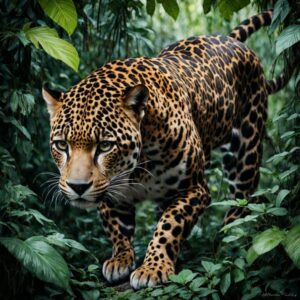Animals
Mysterious Deep Forest Animals
The Elusive Jaguar: A Stealthy Predator of the Night

The Enigmatic Okapi: The Giraffe’s Secretive Cousin
The okapi (Okapia johnstoni) is a strange and fascinating creature that resides in the dense rainforests of the Congo Basin in Central Africa. Often referred to as the “forest giraffe,” the okapi is indeed a relative of the giraffe, although it more closely resembles a zebra due to its striking black-and-white striped legs.
Despite its zebra-like appearance, the okapi has a body shape and long neck that hint at its giraffid lineage. This herbivorous mammal is known for being extremely shy and reclusive, rarely seen by humans. The okapi’s elusive nature, combined with its limited geographic range, has made it a symbol of the mystery that the deep forest holds.
Okapis feed primarily on leaves, fruits, and fungi found in the understory of the forest. They play a crucial role in their ecosystem by helping to disperse seeds and maintain the health of the forest. Unfortunately, okapis are threatened by habitat loss and hunting, making conservation efforts in the region essential for their survival.
The Ghostly Aye-Aye: A Creature of Night and Superstition
The aye-aye (Daubentonia madagascariensis) is one of the most bizarre and misunderstood animals in the world. Native to the rainforests of Madagascar, this nocturnal primate is instantly recognizable by its large eyes, bushy tail, and especially its elongated, thin middle finger, which it uses to tap on trees to locate grubs and insects.
The aye-aye’s unusual appearance and strange behavior have led to a number of superstitions surrounding it. In some local cultures, the aye-aye is considered a harbinger of bad luck or even death, leading to the unfortunate killing of these harmless creatures. Despite these myths, the aye-aye is a highly specialized animal with remarkable adaptations that allow it to thrive in its environment.
As a species, the aye-aye is classified as endangered due to habitat destruction and hunting. Conservation programs focused on protecting Madagascar’s unique biodiversity are essential for the aye-aye’s continued survival, as well as the preservation of the island’s other endemic species.
The Silent Phantom: The Snow Leopard of the Forest
Although snow leopards (Panthera uncia) are typically associated with mountainous regions, they can also be found in the dense forests of Central Asia. These big cats are known as “ghosts of the mountains” due to their elusive nature and their ability to blend into their surroundings. In the forested regions of their range, snow leopards have adapted to the challenges of dense vegetation and rugged terrain.
Snow leopards are solitary animals with an impressive ability to traverse steep slopes and leap across large distances. Their thick fur provides insulation against the cold, while their long tail helps with balance and serves as a blanket during rest. Snow leopards are apex predators, feeding on animals such as blue sheep, ibex, and smaller mammals.
Despite their adaptability, snow leopards are threatened by habitat fragmentation, poaching, and conflict with local herders. Conservation efforts, including community-based initiatives and habitat protection, are crucial for ensuring the survival of this enigmatic species.
The Mystical Owl: Guardians of the Night
Owls have long been associated with mystery and wisdom, their silent flight and haunting calls earning them a place in folklore around the world. Deep within the forests, various species of owls have evolved to become masters of stealth and precision. Among these are the great horned owl (Bubo virginianus) and the barn owl (Tyto alba), both of which are adapted to life in the forest.
The great horned owl is known for its distinctive ear tufts and powerful talons, which it uses to capture prey such as rodents, birds, and even small mammals. This owl’s ability to rotate its head almost 270 degrees gives it an unparalleled field of vision, allowing it to detect prey in the dim light of the forest.
Barn owls, with their heart-shaped faces and ghostly appearance, are equally fascinating. They are expert hunters, using their exceptional hearing to locate prey in complete darkness. The barn owl’s soft feathers enable it to fly silently, surprising its prey before they have a chance to escape.
Owls play an important role in controlling rodent populations and maintaining the balance of forest ecosystems. However, like many forest-dwelling animals, owls are vulnerable to habitat loss and environmental changes. Protecting their habitats is essential for ensuring that these mysterious guardians of the night continue to thrive.

The Reclusive Pangolin: The World’s Most Trafficked Mammal
Forest Animals-Pangolins are among the most enigmatic and endangered creatures in the deep forests of Africa and Asia. These nocturnal mammals are known for their unique scales, which are made of keratin—the same material as human fingernails. Pangolins are the only mammals fully covered in scales, which they use as armor against predators.
Despite their formidable defenses, pangolins are highly vulnerable to poaching, primarily driven by illegal wildlife trade. Their scales are highly valued in traditional medicine, and their meat is considered a delicacy in some cultures. As a result, pangolins have become the most trafficked mammals in the world.
Pangolins play a crucial role in their ecosystems by controlling insect populations, particularly ants and termites, which they consume in large quantities. Conservation efforts are underway to protect pangolins from extinction, including stronger enforcement of wildlife trade laws and habitat preservation.
The Hidden Jewel: The Resplendent Quetzal
The resplendent quetzal (Pharomachrus mocinno) is a bird of extraordinary beauty that inhabits the cloud forests of Central America. Revered by ancient Mesoamerican civilizations, the quetzal is a symbol of freedom and wealth. Its iridescent green and red plumage, along with its long tail feathers, make it one of the most visually stunning birds in the world.
Quetzals are notoriously difficult to spot in the wild due to their preference for dense, misty forests. They are frugivores, feeding primarily on fruits such as wild avocados, which they help to disperse throughout the forest. This role makes them important contributors to the regeneration of their forest habitats.
Unfortunately, the resplendent quetzal is threatened by deforestation and habitat fragmentation. Conservation efforts aimed at preserving cloud forests are vital to ensure the survival of this magnificent species, as well as the many other creatures that share its habitat.
Learn more: zgladnews

